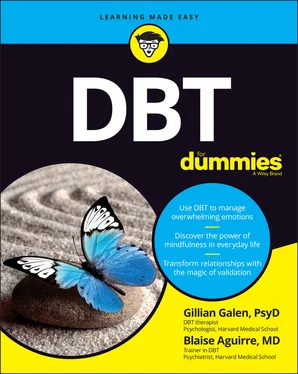If you can keep these questions in mind, you can build the awareness to decrease reactivity and increase your sense of choice of how to move on a skillful path toward regulation.
Identifying and Handling Problem Areas
We all have problem areas. In DBT we have a number of skills training assumptions, and two of the most important ones are that we are all doing the best we can, and we need to do better, try harder, and be more motivated to change. Problem areas, or areas of emotional vulnerability, are a reality. It can be helpful to not get lost in judgment about problem areas, but instead to embrace them as nuggets of wisdom that you know about yourself and that you can build awareness and skills to manage.
Looking at what causes you distress
Looking at what commonly causes you distress can help you anticipate challenging situations. When you can anticipate difficult situations or interactions, it gives you time to plan ahead so that you aren’t continually experiencing distress in the same situations. Knowing your common areas of distress will also help you validate your experience, which, as we discuss earlier in this chapter, will help you keep painful emotions from building in intensity.
 A wide range of things cause people distress, and each of us has unique areas that we find harder to manage, based on our sensitivity and experiences. When you begin to think about this, some situations may be quite obvious and easy to identify, while others may take more time to figure out. Consider the following questions:
A wide range of things cause people distress, and each of us has unique areas that we find harder to manage, based on our sensitivity and experiences. When you begin to think about this, some situations may be quite obvious and easy to identify, while others may take more time to figure out. Consider the following questions:
Is there something you do that repeatedly causes you distress (posting on social media, being with certain people, going to certain places)?
Are there certain relationships or interactions that repeatedly cause you distress?
Are there certain holidays or gatherings that repeatedly cause you distress?
Are there certain places you go (work, school, restaurants, people’s houses) that repeatedly cause you distress?
Are there situations that repeatedly cause you distress (hearing the word no, receiving a compliment, receiving feedback at work or from a friend, saying no to someone)?
Are there certain emotions that are harder to manage and that frequently cause you distress?
Thinking about these experiences will help you narrow down specific areas that you can focus your skills on so that you don’t keep finding yourself in similar painful situations over and over again.
Figuring out coping solutions
 In Part 3of this book, we introduce the DBT skills that, with practice, you can use as coping solutions. Remember, sometimes the solutions are simply tolerating and accepting the reality in front of you, while other skills will help you solve problems, turn up or down the intensity of your emotions, or be more effective in your relationships or interactions with others. Being able to understand and identify your emotions is the first and very critical step in coping. Often, people skip over this step, and when that happens, they rarely choose the most effective skill to meet their goal.
In Part 3of this book, we introduce the DBT skills that, with practice, you can use as coping solutions. Remember, sometimes the solutions are simply tolerating and accepting the reality in front of you, while other skills will help you solve problems, turn up or down the intensity of your emotions, or be more effective in your relationships or interactions with others. Being able to understand and identify your emotions is the first and very critical step in coping. Often, people skip over this step, and when that happens, they rarely choose the most effective skill to meet their goal.
Chapter 6
Understanding Your Behaviors
IN THIS CHAPTER
 Connecting what you feel to how you act
Connecting what you feel to how you act
 Recognizing and dealing with triggers
Recognizing and dealing with triggers
 Linking specific behaviors to specific reactions
Linking specific behaviors to specific reactions
Many of us in the mental health field find human behavior to be fascinating. Observing patterns of behavior and trying to predict what a person is going to do next can be useful in establishing what is helpful and what is not, and what interventions to use if behavior is to be changed. And yet in many instances, behavior is very predictable, because it’s patterned through repetition. Take a behavior like walking. Because of repetition, it’s predictable that a person will walk when getting from point A to point B. And yet walking is a relatively simple behavior. Behaviors that emanate from strong emotions can be very complex and much harder to predict.
People who are emotionally sensitive generally experience life with more intensity than those who are less sensitive. Typically, with more sensitivity comes a greater degree of behavioral variability.
There is nothing problematic with being more emotionally sensitive. Many artists, therapists, actors, musicians, and others recognize that being sensitive is helpful to their craft. However, people who have strong emotions can be at risk of behaving in ways that are dependent on their mood state. Mood-dependent behavior is often what causes people to request DBT therapy for two main reasons: The first is the person doesn’t have the skills to effectively manage emotionally charged situations, and the second is the behavior that happens when a person acts on their feelings or urges without pausing to consider the consequences of the behavior can lead to suffering in the person’s life. Often, mood-dependent behaviors seem automatic and seem to happen quickly, as if the person had no choice. They seem to come from nowhere and appear to be out of an individual’s control, and because of this, they can seem hard to change given the powerful underlying emotions, urges, and often negative thoughts driving them.
In this chapter, we review the connections between feelings and actions, recognize the triggers that set off behaviors, and look at how we can link specific behaviors to specific reactions as a way to begin to change unhelpful behaviors.
Being Aware of How Your Emotions Manifest in Action
When you’re engaging in mood-dependent behavior, you’re acting on the urges caused by your underlying emotional state. An example of this is when, for instance, you have a low mood and have the urge not to get out of bed or see anyone. Staying in bed and not seeing your friends would be mood-dependent behavior. If you are feeling angry and lash out at your co-worker for a seemingly trivial transgression, that is mood-dependent behavior.
For people who are prone to such behavior, when the mood has passed, they can often feel guilty or shameful about their behavior. In the moment, however, the person acting on their emotions without thinking frequently feels justified and right for having done so. The alternative of stopping and reflecting on what to do, or even tolerating the discomfort of the emotion, can feel unbearable. Mood-dependent behavior can bring instant relief and feels great in the short run, only to cause greater harm in the long run.
 For any individual, every emotion has an action urge, and it’s a core part of DBT for the person to know their typical behavior when they are feeling strong emotions. If you struggle in this way, being mindful is key to developing the awareness of how your emotional state in the present moment leads to these behaviors. Mindfulness is also key to then having a more deliberate response. This means that when a strong emotion arises, you should take the time to pause and ask yourself the following:
For any individual, every emotion has an action urge, and it’s a core part of DBT for the person to know their typical behavior when they are feeling strong emotions. If you struggle in this way, being mindful is key to developing the awareness of how your emotional state in the present moment leads to these behaviors. Mindfulness is also key to then having a more deliberate response. This means that when a strong emotion arises, you should take the time to pause and ask yourself the following:
Читать дальше

 A wide range of things cause people distress, and each of us has unique areas that we find harder to manage, based on our sensitivity and experiences. When you begin to think about this, some situations may be quite obvious and easy to identify, while others may take more time to figure out. Consider the following questions:
A wide range of things cause people distress, and each of us has unique areas that we find harder to manage, based on our sensitivity and experiences. When you begin to think about this, some situations may be quite obvious and easy to identify, while others may take more time to figure out. Consider the following questions: Connecting what you feel to how you act
Connecting what you feel to how you act










